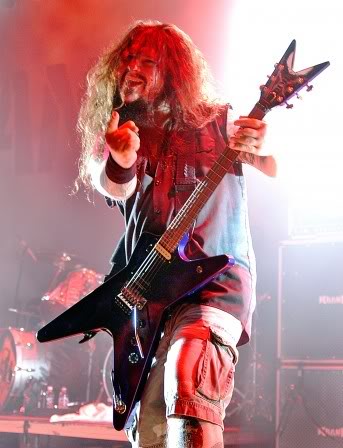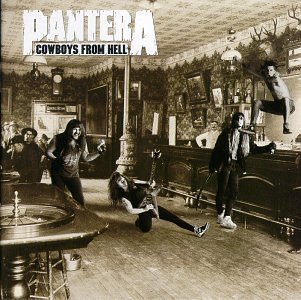• Country rock band, Cross Canadian Ragweed debuted the song "Dimebag" while on tour to promote the album Garage, The band performed the song live for the first time at the newport music hall in Columbus, Ohio in early 2005.
• A live version of Shinedown's cover of Simple Man is dedicated to Dimebag Darrell
• Trivium's album, The Crusade, says at the bottom of the final page, "Rest in peace Dimebag Darrell Abbott (1966-2004)"
• Disturbed in their 2005 release Ten Thousand Fists stated: "We would like to dedicate this record to the memory of our late fallen brother, Dimebag Darrell, one of the greatest guitar players to ever walk the face of this Earth"
• In the Limp Bizkit song "The Priest" you hear the lyrics "I see someone in rage killing Dimebag on stage...".
• French metal band Watcha dedicated a song on the album "Phenix" called "Dimebag". Lyrics contains many titles of Pantera soundtrack.
• Guitarist Buckethead wrote "Dime", a song paying tribute to Abbott, which was available for free download shortly after Abbott's death. The song later made it onto Buckethead's album Kaleidoscalp, entitled "The Android of Notre Dame".[20]
• He Came to Rock is a DVD/book tribute to Abbott released in November 2008. Darrell's brother Vinnie Paul and father Jerry toured to promote the book's release.[21]
• The booklet in C.O.C.'s In the Arms of God album says "R.I.P. Dime" at the bottom of the last page.
• The song "Side of a Bullet" by Nickelback is a tribute to Dimebag; it takes place in a world where the killer is still alive and has lyrics such as, "He hit the stage so full of rage and let the whole world know it/6 feet away they heard him say/Oh God, don't let him pull it." An unreleased solo recorded by Dimebag, intended for Damageplan was mixed into the song.
• Metal band Machine Head dedicated a song to Dimebag on their album "The Blackening", called Aesthetics of Hate. The song's lyrics are meant as a vicious retaliation against the Christian-conservative website "The Iconoclast," who hosted an article of the same name bashing Darrell after his death. Also, on their tour with this album, they honored Dimebag during concert, by taking time to tell Dime's story. "Aesthetics of Hate" remains a mainstay on tour and is always dedicated in memory of Darrell. Rob Flynn was a friend of Darrell's, who also took the time to remark both on how talented and how generous he was - reportedly, Rob owns a custom-made Washburn Dimebag guitar which was given to him as a replacement after Dimebag broke his touring guitar, but can't use it on stage due to contract disagreements, he used this guitar to record "Aesthetics of Hate". Machine Head have also recorded a cover of the Pantera song Fucking Hostile for the Metal Hammer magazine tribute CD.[22]
• Static-X's album Start A War was dedicated to Dimebag Darrell as it says in the inner booklet of the CD.
• In Avenged Sevenfold's City of Evil album, the song Betrayed is labeled as "In memory of Darrell Lance Abbott-"Dimebag Darrell". Also Avenged Sevenfold did a cover of the Pantera song Walk.
• The 2006 live album Garage by Cross Canadian Ragweed features the song "Dimebag" which is about "Dimebag" Darrell and makes references to his songs and death.
• In 2006, Malibu punk/metal band 2Cents released "Lost at Sea" (Atlantic Records)which features a tribute song to Abbott titled "A Song for Darrell Abbott".
• Finnish Metal band Kiuas´ song "Bleeding Strings" from their 2006 album "Reformation" is dedicated to Dimebag Darrell.
• Phil Anselmo's band Down now dedicates the song Lifer, from NOLA, to Dimebag Darrell when performed live.
• Black Label Society now dedicates the song "In This River" to Dimebag.
• Brides Of Destruction paid tribute to Dimebag Darrell on their 2005 release, Runaway Brides, with the track "Dimes In Heaven".
• The lyrics of metal band Abnormality's 2007 song Visions are about Dimebag Darrel's death.
• Leave it Alone (with Jason Bittner, David Ellefson, Tristan "1690" Grigsby, Nick Bowcott and Brian Cashmore) - A Tribute to Dimebag Darrell
• The progressive death metal band Between The Buried And Me did a cover of Cemetery Gates on their album "The Anatomy Of".
• While playing in Hammersmith in 2004, Melodic Death Metal band In Flames played a cover of "Fucking hostile" and dedicated it to the memory of Dimebag Darrell.
• The 2009 album 11:11 by Rodrigo y Gabriela features a tribute track named "Atman" 'inspired by Dimebag Darrell never to be forgotten lead guitarist in Pantera and Damageplan, who was tragically murdered onstage in 2004' [23]
• Bullet For My Valentine did a cover of the Pantera song Domination.
• The popular video game Guitar Hero II lists all of the guitarists of the bands featured in the games, and at the very end it says "R.I.P. Dimebag".
• Ace Frehley's 2009 solo album Anomaly is dedicated to Dimebag.
• The artist Kat created an original painting "Razorback" in memory of Dimebag Darrell and all musicians who lost their lives prematurely.
• Slayer guitarist Kerry King drinks a shot at the end of live performances as a tribute to Darrell and usually leaves one shot on stage "For Dime".
• Type O Negative plays "Halloween in Heaven" off of the Dead Again album as a tribute to Dimebag when playing live.
• The video game character Axel Steel from Guitar hero III has an alternative outfit that highly resembles Dimebag, featuring camouflage shorts, sneakers and a goatee with a red tip.
• Brian Welch (former guitarist of the band Korn) made an only-guitar song dedicated to Dimebag called "Letter to Dimebag".
• The booklet in the Evanescence album "The Open Door", in Terry Balsamo's section says "..R.I.Pdimebag.."
• Detroit groove-metal band Myth Not Man ends every one of their shows with a cover of the Pantera song "Becoming" in tribute to Dimebag Darrell's influence on their guitar player's (Joey Davis') style and their music.
• In the computer game Brütal Legend, the Ormagöden loading icon is replaced by a Dime icon on December 8th.
• A song on Guitarist Michael Angelo Batio's new album "Hands without Shadows 2 - Voices" titled "Tribute to Dimebag" where he covers Pantera's "cowboys from hell"
• At the bottom of the track listing of Ace Frehley's album Anomaly (album) it says "dedicated to Eric Carr and Dimebag Darrell"
• A tribute album by UK magazine Metal Hammer will pay tribute to Dimebag. It will come along with the magazine, which goes on sale December 16, 2009. The tracklisting is as follows:
1. Zakk Wylde - Suicide Note Part 1
2. Machine Head - Fucking Hostile
3. Malefice - I'm Broken
4. Avenged Sevenfold - Walk
5. Evile - Cemetery Gates
6. Five Finger Death Punch - A New Level
7. Biohazard - Mouth for War
8. Sylosis - Strength Beyond Strength
9. Chimaira - Slaughtered
10. Unearth - Sandblasted Skin
11. Throwdown - Becoming
12. Kiuas - This Love
13. This is Hell - Rise
14. Nonpoint - 5 Minutes Alone*
15. In Flames - Fuckin Hostile/Behind Space



















